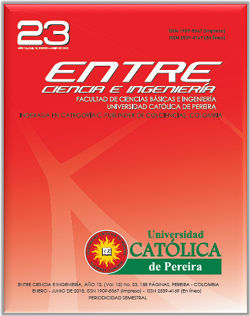Statistical analysis of solar radiation in the city of Cúcuta
DOI:
https://doi.org/10.31908/19098367.3698Keywords:
Global solar radiation, sun peak hours, insolation, R StudioAbstract
This work presents a statistical analysis of solar radiation in the city of Cúcuta, Norte de Santander, Colombia. The main purpose of this study is to provide a thorough description of the solar energy available in this territory. To perform the analysis, we processed data of hourly global solar radiation during a period of nine years; we used R software to execute diff erent types of statistical calculations. In this paper, we present graphs to summarize the values of global solar radiation for each month and the whole year. Furthermore, we obtained 5.335 sun peak hours for the city of Cucuta and proposed an equation to estimate global solar radiation from historical data for this site. This research aims to quantify, from a statistical point of view, the solar resource available in the city of Cucuta.
Downloads
References
Hulstrom, R. Solar Resources. MIT Press, 1989.
National Aeronautics and Space Administration (NASA), “Solar Radiation and the Earth System.” [Online]. Available: http://education.gsfc.nasa.gov/experimental/July61999siteupdate/inv99Project.Site/Pages/science-briefs/ed-stickler/ed-irradiance.html.[Accessed: 24-Jan-2017].
Balfour, J. R.,Shaw, M. and Jarosek, S. Introduction to Photovoltaics. Jones & Bartlett Publishers, 213p. 2011.
Leal, F. A. and Hernandez Cely, M. M. “Study of wind and solar potential in Cucuta, Norte de Santander,” Rev. Colomb. Tecnol. Av. vol. 2, pp. 27–33, 2013.
Che, H. Z., Shi, G. Y., Zhang, X. Y., Arimoto, R., Zhao, J. Q., Xu, L., Wang, B. and Chen, Z. H. “Analysis of 40 years of solar radiation data from China, 1961– 2000,” Geophys. Res. Lett. vol. 32, pp. 1–5, 2005.
Omran, M. A. “Analysis of solar radiation over Egypt,” Theor. Appl. Climatol., vol. 67, no. 3–4, pp. 225–240, Dec. 2000.
Mejía, J. S., Mosquera, L.A. and Betancourth, J. “Síntesis dimensional de un mecanismo esférico para la orientación de paneles solares,” Entre Cienc. e Ing., Vol 11, no. 22, pp. 43–50, 2017.
Poveda Jaramillo, G. “Retroalimentación Dinámica entre el Fenómeno El Niño-Oscilación del Sur y la Hidrología de Colombia,” Tesis doctoral, Facultad de Minas, Universidad Nacional, nov. 1998.
International Research Institute for Climate and Society, “IRI ENSO Forecast.” [Online]. Available: https://iri.columbia.edu/our-expertise/climate/forecasts/enso/2015-november-quick-look/ [Accessed: 12-Dic-2016] .
Ferrari, S., Lazzaroni, M., Piuri, V., Salman, A., Cristaldi, L. and Faifer, M. “Computational Intelligence Models for Solar Radiation Prediction.” 2013 IEEE International Instrumentation and Measurement Technology Conference (I2MTC), Minneapolis, MN, 2013, pp. 757-762. doi: 10.1109/I2MTC.2013.6555517
Kabacoff, R. “R in Action: Data Analysis and Graphics with R”. Manning, 474p., 2015.
Sabadías, A. V. “Estadística descriptiva e inferencial”. Univ de Castilla La Mancha, Colección Ciencia y Técnica, 576p.1995.
MathWorks, “Evaluating Goodness of Fit - MATLAB & Simulink.” [Online]. Available: https://www.mathworks.com/help/curvefit/evaluating-goodness-of-fit.html?requestedDomain=www.mathworks.com. [Accessed: 13-Feb-2017].
UPME. Unidad de Planeación Minero Energética, “Integración de las energías renovables no convencionales en Colombia.” 2015 [Online]. Available: http://www.upme.gov.co/Estudios/2015/Integracion_Energias_Renovables/INTEGRACION_ENERGIAS_RENOVANLES_WEB.pdf. [Accessed: [21-Ene-2017].






 Revista Entre Ciencia e Ingeniería
Revista Entre Ciencia e Ingeniería .png) entrecei@ucp.edu.co
entrecei@ucp.edu.co.png) ISSN (Impreso) 1909-8367 - ISSN (En Línea) 2539-4169
ISSN (Impreso) 1909-8367 - ISSN (En Línea) 2539-4169 Attribution-NonCommercial 4.0 International (CC By-NC 4.0)
Attribution-NonCommercial 4.0 International (CC By-NC 4.0)
.png) Carrera 21 No. 49-95 Av. de las Américas, Pereira, Risaralda, Colombia
Carrera 21 No. 49-95 Av. de las Américas, Pereira, Risaralda, Colombia